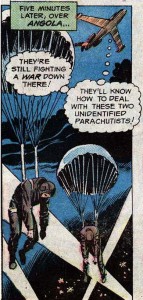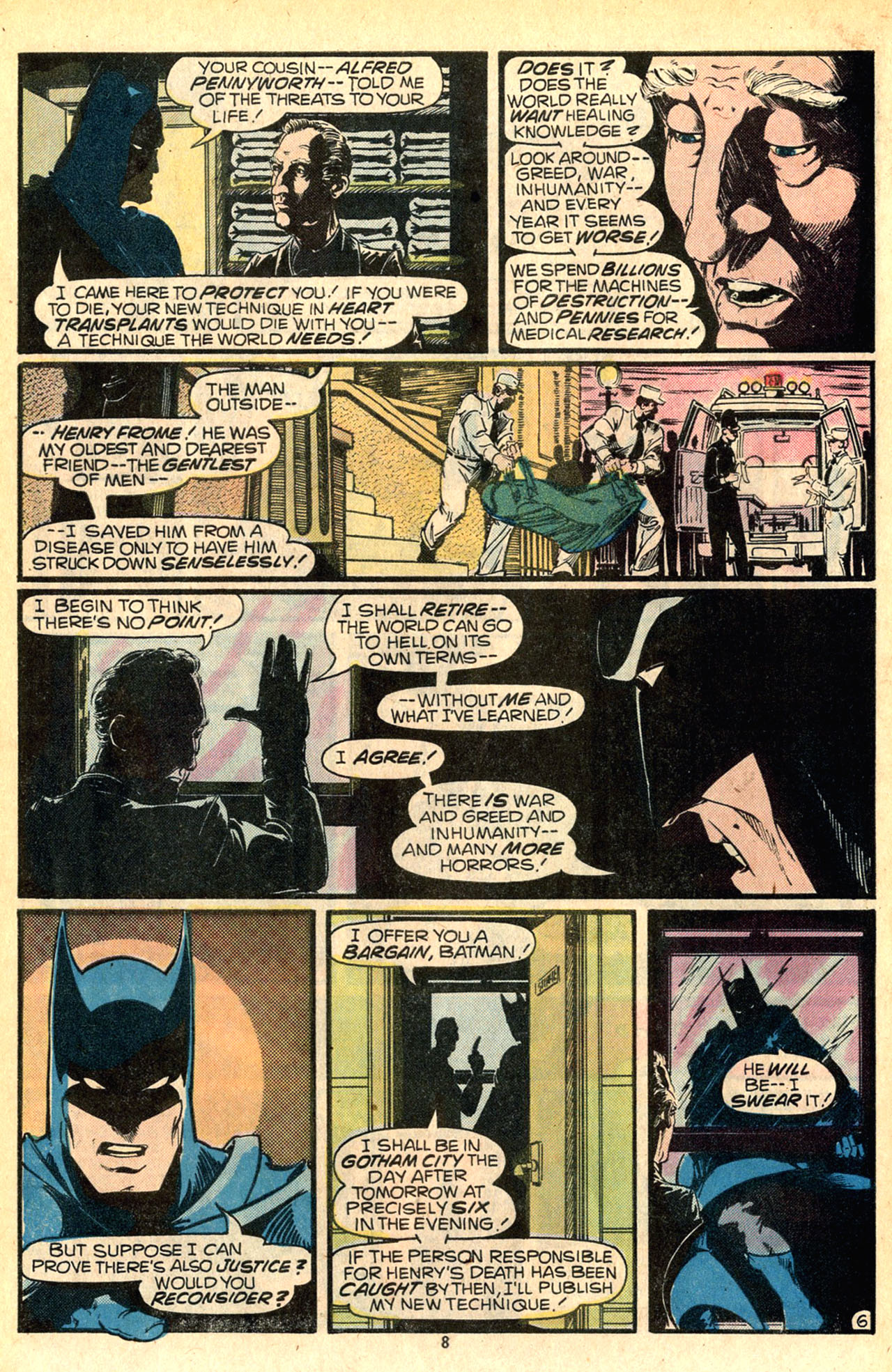While access to new sources and archives, not to mention shifting paradigms and the cultural turn, have helped produce a historiography on the Cold War that moved beyond orthodox, revisionist, and neorealist interpretations to embrace, among others, constructivist, postcolonial, pericentric, transnational, and semiotic studies of the topic, it is my conviction that the abundant scholarly literature doesn’t mention often enough the fact that Batman once fought a guy called KGBeast.
Here is the first of a few of posts which will help fill this, and other, unforgivable gaps in the public’s understanding of the Cold War. After all, as a character who both preceded and outlasted the conflict – and one prone to incorporate the Zeitgeist into his comics with little regard for subtlety or tastefulness – Batman naturally faced more than his share of Cold War-related challenges. Hell, the Dynamic Duo even did its part to prevent the East German Stasi from dismantling a network that smuggled people out of the GDR:
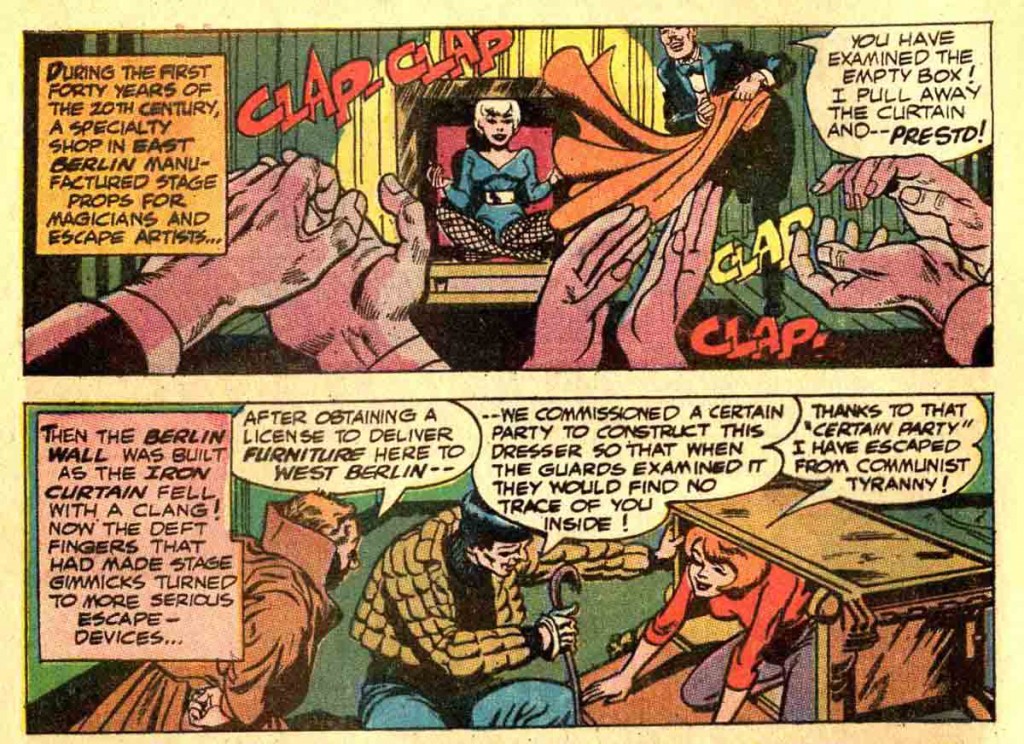 Detective Comics #361
Detective Comics #361
…and sure, that issue may not get points for treating the subject matter with the complexity it deserves, but if you’re going to nitpick, then I’ll have to point out that it is still more historically accurate than the Batman movie released around the same time, where West Germany showed up as a UN member a whole 7 years before it joined the organization!
That said, the Dark Knight’s role in the Cold War was more than just patriotically beating up red scum while spouting chauvinistic one-liners. In fact, with the onset of international détente and rising domestic anti-militarism in the late 1960s and early 1970s, the varied team behind Batman comics started shooting in all directions, each writer with his own distinctive approach, from Bob Haney’s anything-goes sense of spectacle to Mike Friedrich’s youthful idealism.
You can see this diversity, for example, in the plethora of villains who tried to go atomic. While nuclear threat stories dated at least as far back as the very start of the Cold War…
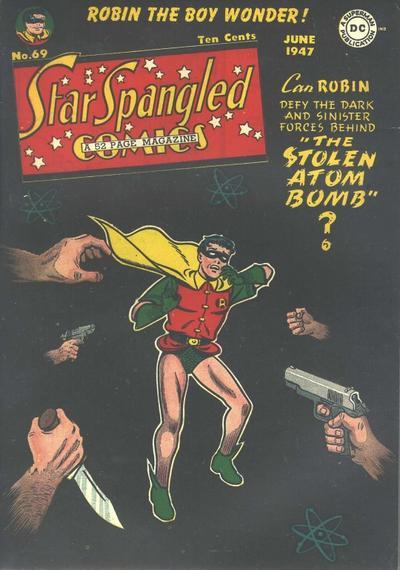 Star Spangled Comics #69
Star Spangled Comics #69
…the fear of annihilation was as topical as ever in the post-Cuban Missile Crisis, post-Dr. Strangelove era. The enemy, though, was not necessarily outside. In the exciting ‘The Doomsday Ball!’ an unidentified terrorist holds Gotham City for ransom by threatening to blow it up with a miniaturized hydrogen bomb stolen from the military. ‘The Threat of the Two-Headed Coin!’ concerns a bomb threat as well, but this time behind it is a disenchanted American general, who is clearly quite unbalanced:
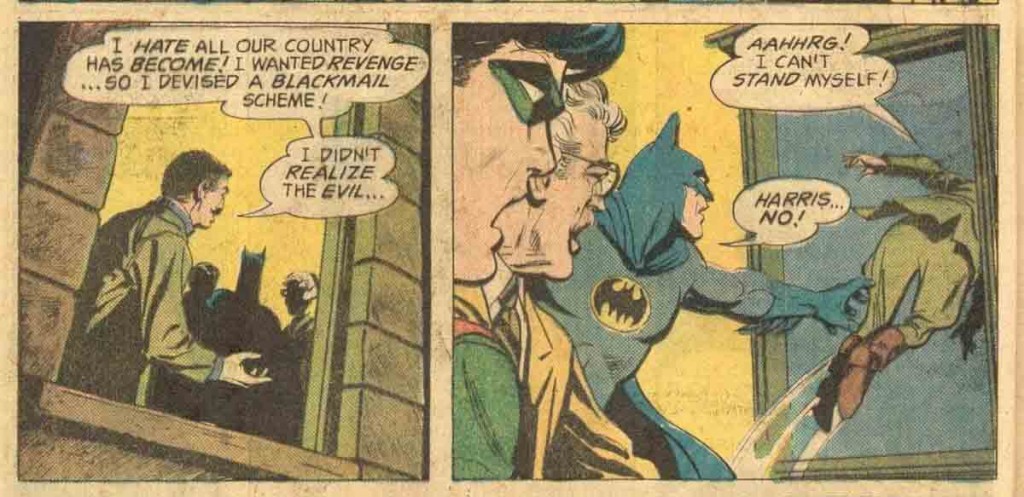 Batman #258
Batman #258
Also involved is the villain Two-Face, who wants to blackmail the government. And being obsessed with duality, of course he soon tries it a second time. Suitably taking advantage of the Cold War’s bipolar world order, Two-Face steals a security-related binary code and flirts with national treason (or double-cross, as he prefers to call it) by threatening to sell the code to America’s biggest enemy unless Washington pays him 22 million dollars. This leads to a great moment in which representatives of the two superpowers realize the kind of twisted criminal logic Batman has to deal with on a daily basis:
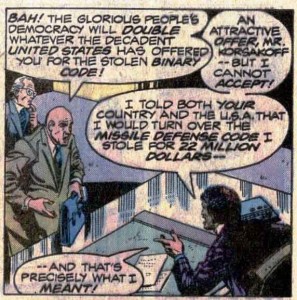
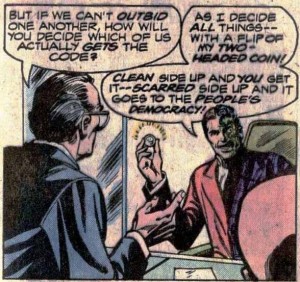 Batman #314
Batman #314
All of this is not to say that foreign Marxists never tried to blow up Gotham City with nuclear weapons. If nothing else, statistically it had to happen, since Gotham gets threatened with total destruction at least twice a year. And ironically, when anti-Western, anti-capitalist, anti-Batman urban guerrillas try their luck, the Dark Knight saves the day by literally throwing money at them:
 Batman #305
Batman #305
The series that engaged more often with the Cold War was Bob Haney’s The Brave and the Bold, which is not surprising, since anything could happen on the pages of that book. Haney’s approach to writing was apparently to throw in every idea he could come up with, no matter how outrageous, in the hopes of knocking readers out. Thus, while the Cold War is there, the prospect of mutually assured destruction doesn’t always seem like the maddest thing going on in the story. When a villain hijacks the Brotherhood Express, a train promoting friendship with the allies of the US, this is just a pretext for Batman to fight a guy called Cannoneer and his crew atop a moving train, using props shaped like easily recognizable foreign landmarks:
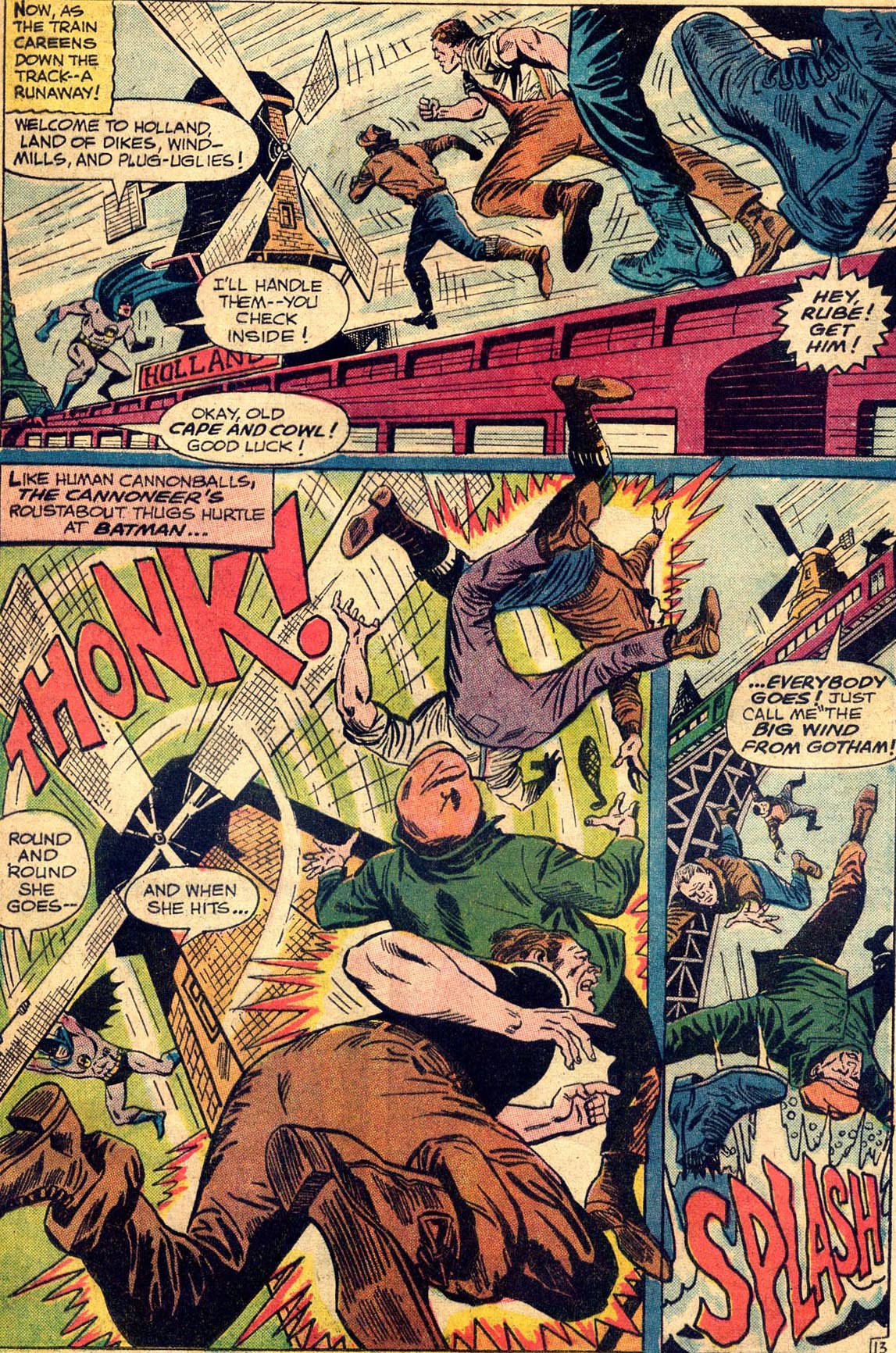 The Brave and the Bold #77
The Brave and the Bold #77
Bob Haney’s Batman was not adverse to collaboration with high level authorities, undertaking enough preposterous missions across the world to make James Bond adventures seem like grounded, realistic, le Carré-penned tales of espionage. In ‘Count Ten… And Die!’ Anglo-American military intelligence asks the Dark Knight to retrieve Soviet plans to launch an armed space station during the World Youth Games, in Vienna (and while he’s in town, Batman also takes time to motivate the heavyweight boxer known as Wildcat for a Rocky IV-type match against a Russian champ). In ‘Nightmare without End,’ the Caped Crusader helps unmask an East German double agent in a small German village, appropriately named Kleindorf. In ‘What Lurks Below Buoy 13,’ Batman actually goes rogue, refusing to hand over an undersea satellite that could tip the balance of terror between American and Soviet nuclear submarines, instead leaving it to the care of the non-aligned Aquaman. In ‘Death by the Ounce,’ the Soviets hire an aging alien goddess to kidnap a Middle Eastern shah, paying her with an innovative youth serum.
The most entertaining tale by far is ‘A Traitor Lurks inside Earth!’ where the US centralizes its anti-missile defense system in a robot who decides that the only way to end war, poverty, and injustice is for machines to take power, in the process kick-starting a whole robot civil rights movement against the human establishment:
 The Brave and the Bold #103
The Brave and the Bold #103
By contrast, the most disturbing story has to be ‘Demolishment!’ where Batman goes after Green Lantern, who has defected to the socialist side, and ends up getting brutally brainwashed:
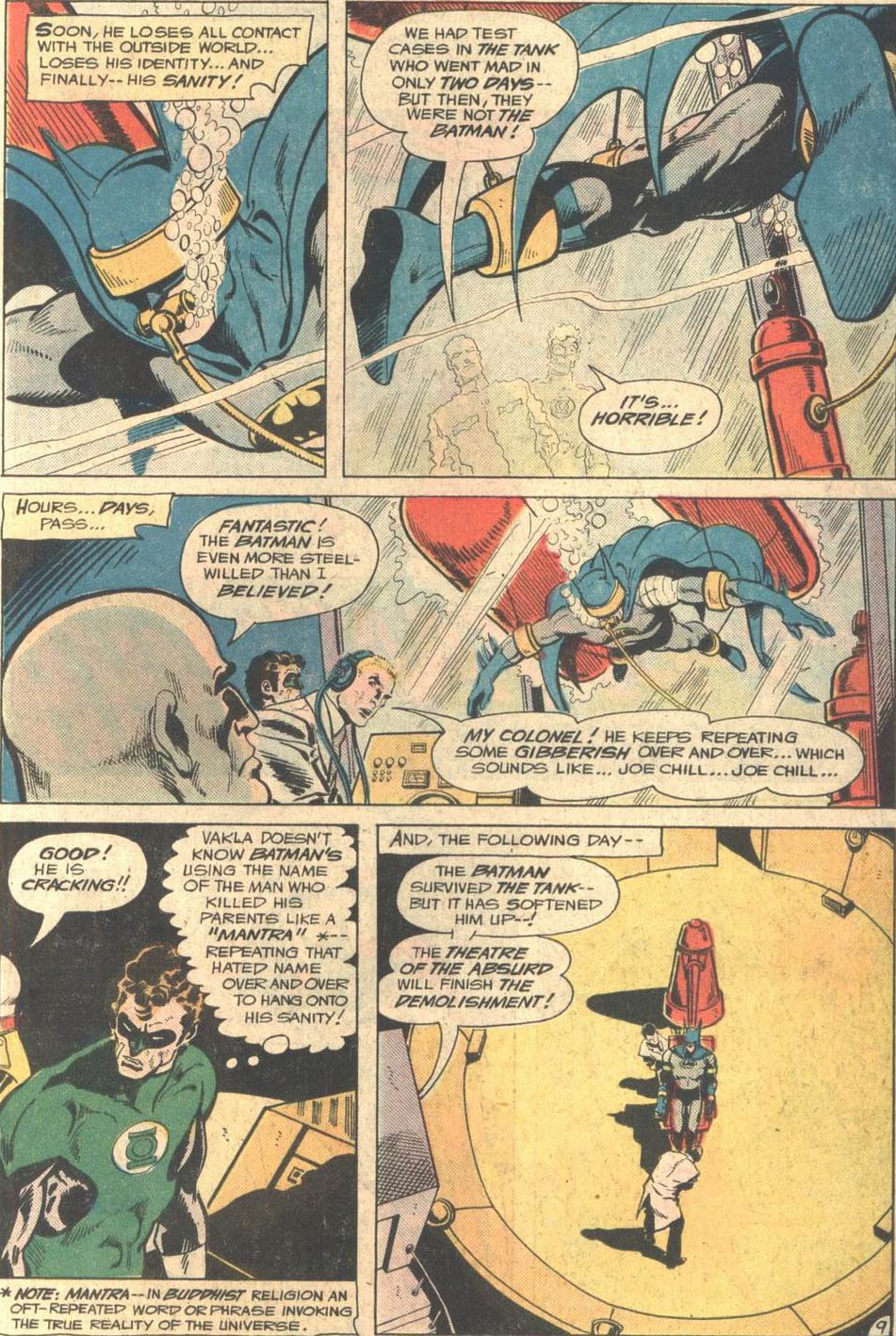
 The Brave and the Bold #134
The Brave and the Bold #134
If you’re looking for old-school anticommunism in the Bat-family, however, look no further than Robin’s backup features in Detective Comics, which detailed Dick Grayson’s adventures among the youth counterculture of Hudson University. At the peak of the anti-establishment movement, writer Frank Robbins dived head-first into the notion of universities as a Cold War front. Covering all angles, in Robin’s first college adventure, ‘Strike…While the Campus is Hot,’ the villains initially seem to be students demanding strike action, then violent cops beating up defenseless protesters, then deceitful activists manipulating students into striking, and ultimately Soviet agents destabilizing the US education system:
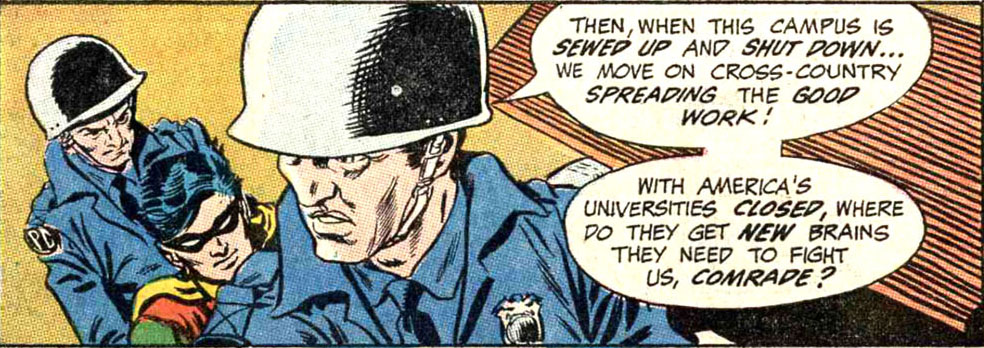 Detective Comics #395
Detective Comics #395
This was followed with a story about a Russian exchange-professor out to discredit NASA as payback for the Americans having put the first man on the moon, something he sought to achieve with a laser beam and some green soap. Don’t ask.
20-year old writer Mike Friedrich also seemed concerned with the home front, yet he was clearly more in tune with current generational sensibilities. A hippy protester against US warmongering served as red herring in Detective Comics #387. Friedrich also famously pitted Batman and other heroes against Johnny Dune, a resentful Vietnam vet using his supernatural voice to mobilize the youth to march against the power, in a political variation of the Pied Piper of Hamelin.
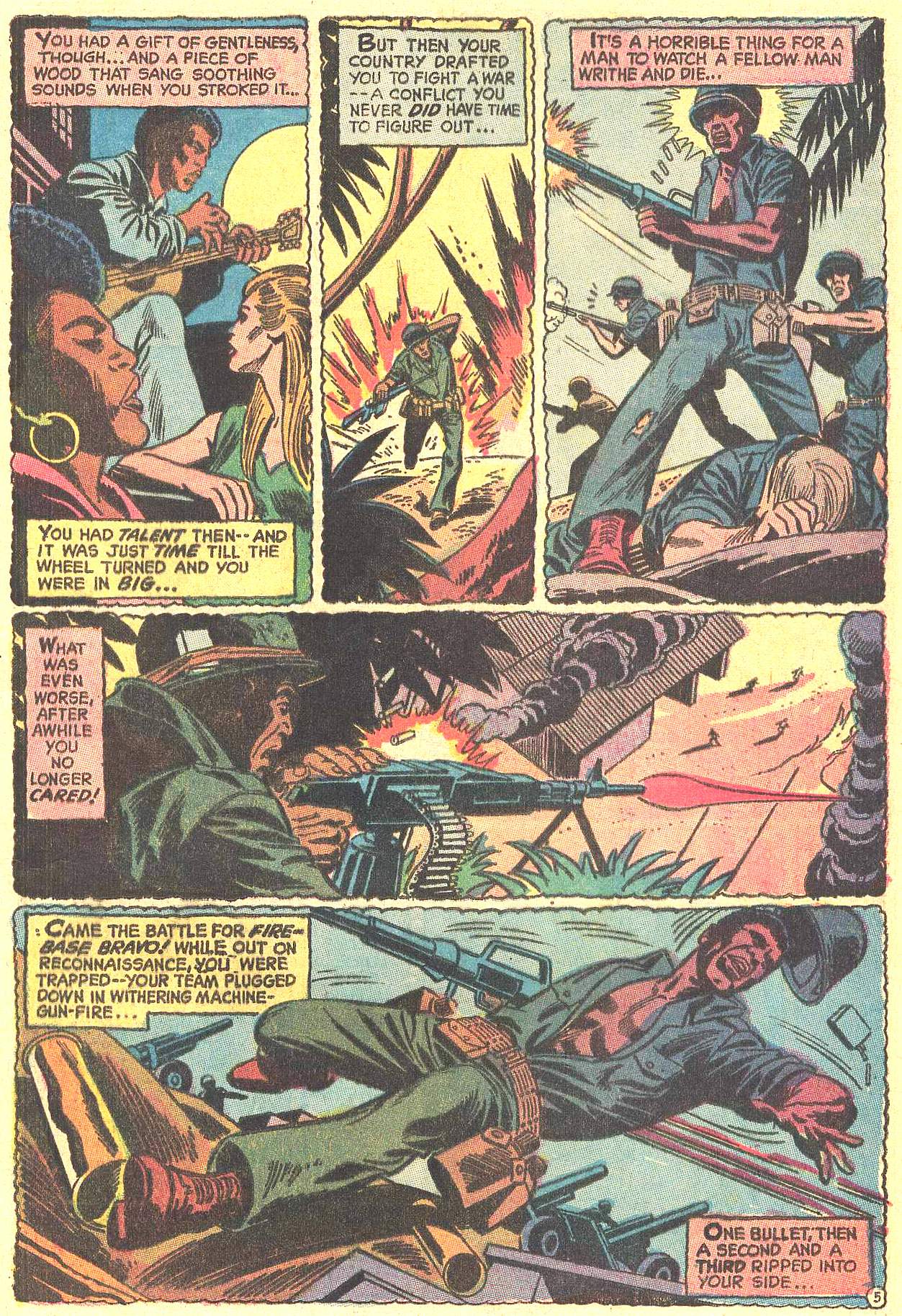
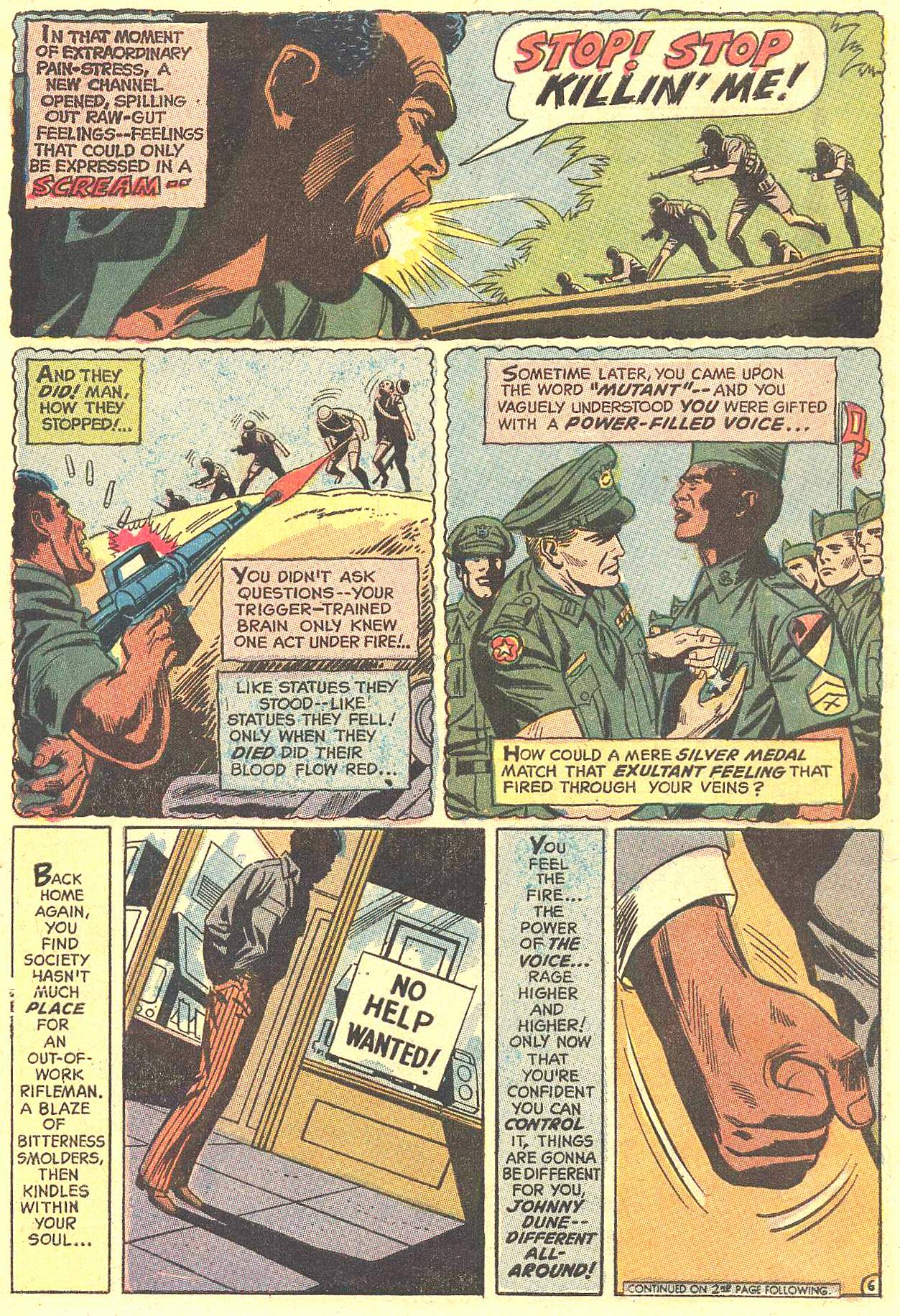 Justice League of America #95
Justice League of America #95
Hauntingly brought to life by Dick Dillin’s pencils and Joe Giella’s inks, described as ‘the best electric rhythm-and-blues man since drugs burned out the life of Jimmy Hendrix,’ Johnny Dune comes across as sympathetic yet misguided, ultimately giving up his revolutionary tactics to pursue electoral politics.
On a more global scale, outside of the pages of The Brave and the Bold the Caped Crusader mostly kept away from international geo-ideological disputes during the détente era, unless of course you count his ongoing struggle to prevent the immortal eco-fundamentalist Ra’s al Ghul from taking over the world. The one time Batman did get directly involved was in ‘The Most Dangerous Twenty Miles in Gotham City,’ where the Dark Knight helped the government carry out a prisoner exchange between Soviet spy Ivanescu and a US agent, the villains being American lunatic-fringe ‘101% super-patriots’ out to kill Ivanescu before the trade could take place.
Batman’s main spy villain during this period was Colonel Sulphur, introduced in the classic ‘At Dawn Dies Mary MacGuffin!’
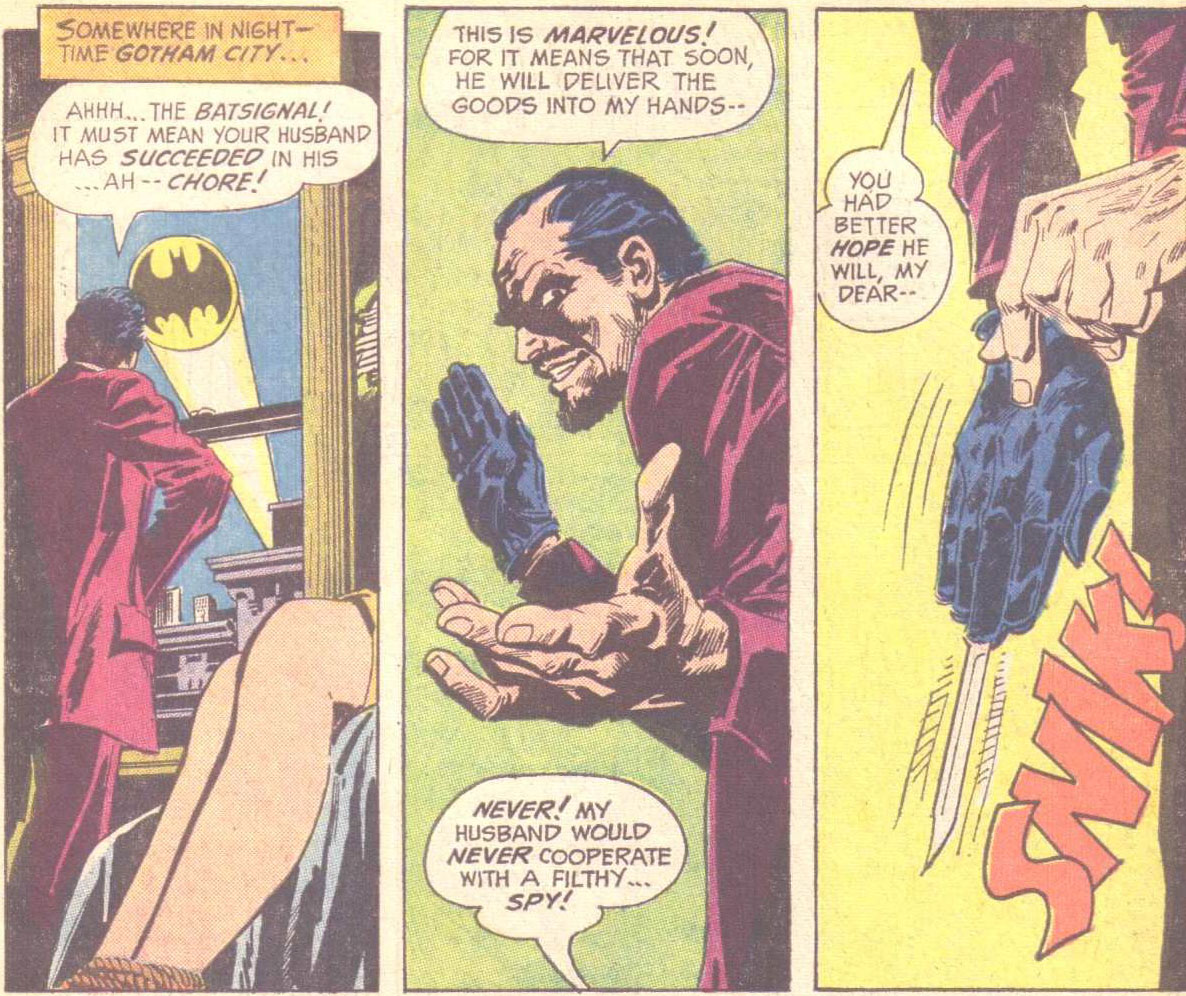 Batman #241
Batman #241
Sulphur heads a freelance spy ring and his work remains unattached to real world politics. Whenever he shows up, Sulphur is after secret American documents, or rocket fuel, or super-weapons, but it isn’t usually clear who exactly he is spying for. In ‘Death-Knell for a Traitor!’ Sulphur is not even spying at all, instead he is just another well-connected criminal looking for a diamond – that issue does have a gloomy, ironic Twilight Zone-worthy ending, but it’s about the trauma of World War II rather than the Cold War.
Only by the mid-1970s, with détente beginning to fall apart, do we finally get a grand, globetrotting espionage adventure in the main title, which if nothing else ought to be remembered for this moment:
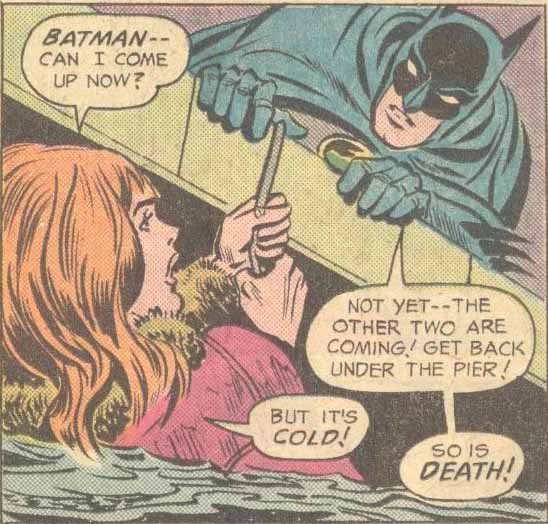 Batman #281
Batman #281
Courtesy of David V. Reed and Ernie Chua, in the storyline running from Batman #281 to Batman #283 a triple murder investigation leads the Dark Knight to look into the disappearance of a defected Hungarian nuclear scientist. This is tied to yet another terrorist plot to – you guessed it – blow up Gotham City with an atomic bomb, unless a one billion dollar ransom is met (you can tell there was rampant inflation since the ‘The Doomsday Bal!’ when the bomber settled for ten million). The investigation takes Batman to Budapest, where we find out that he is well-known on the other side of the iron curtain…
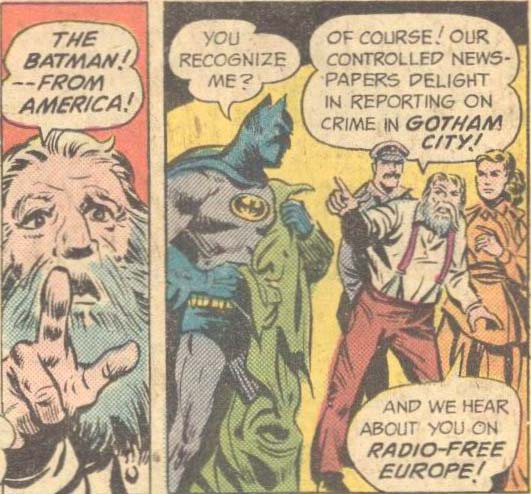 Batman #281
Batman #281
The Caped Crusader goes to Africa as well, where he sadistically disposes of two henchmen by dropping them in the middle of the Angolan Civil War:
Batman #283
Robin was also well-travelled in different Cold War stages, sometimes with his Teen Titans team, sometimes solo. Once he even caught a group of American soldiers stationed in West Germany who justified robbing banks in Stuttgart with the state of the global political economy:
 Detective Comics #487
Detective Comics #487
And yet, if I had to pick the comic that best captures the feeling of all-encompassing violence, paranoia, and despair of the ’70s, it would be ‘Ticket to Tragedy.’ This thrilling story by Denny O’Neil and Marshall Rogers doesn’t feature Batman thwarting bombings, fingering commies, chasing hippies, or fighting robots set up by the military-industrial complex. Instead, after decades of global conflict, the Dark Knight takes it upon himself to accomplish an even more impossible mission – to restore an old man’s hope in humanity:

